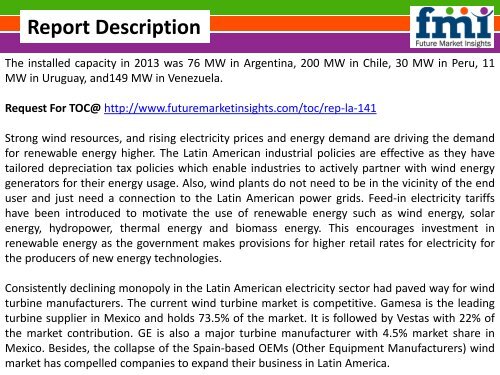Latin America Wind Turbine Market
Wind energy is the power extracted from wind using wind turbines. A wind turbine is a device that transforms the kinetic energy of the wind into electrical energy. Wind energy is a renewable form of energy that is available in ample quantity and extensively. It is an alternative to fossil fuels which are depleting in quantity. Wind energy is the cleanest resource; it has neither toxic gas emissions nor greenhouse gas emissions. Wind turbines are connected to the network of electricity transmission. The onshore and offshore wind that is trapped is an inexpensive, competitive and significant source of energy. Wind energy contributed to 4% of the total global electricity usage in 2013.
Wind energy is the power extracted from wind using wind turbines. A wind turbine is a device that transforms the kinetic energy of the wind into electrical energy. Wind energy is a renewable form of energy that is available in ample quantity and extensively. It is an alternative to fossil fuels which are depleting in quantity. Wind energy is the cleanest resource; it has neither toxic gas emissions nor greenhouse gas emissions. Wind turbines are connected to the network of electricity transmission. The onshore and offshore wind that is trapped is an inexpensive, competitive and significant source of energy. Wind energy contributed to 4% of the total global electricity usage in 2013.
Create successful ePaper yourself
Turn your PDF publications into a flip-book with our unique Google optimized e-Paper software.
Report Description<br />
The installed capacity in 2013 was 76 MW in Argentina, 200 MW in Chile, 30 MW in Peru, 11<br />
MW in Uruguay, and149 MW in Venezuela.<br />
Request For TOC@ http://www.futuremarketinsights.com/toc/rep-la-141<br />
Strong wind resources, and rising electricity prices and energy demand are driving the demand<br />
for renewable energy higher. The <strong>Latin</strong> <strong>America</strong>n industrial policies are effective as they have<br />
tailored depreciation tax policies which enable industries to actively partner with wind energy<br />
generators for their energy usage. Also, wind plants do not need to be in the vicinity of the end<br />
user and just need a connection to the <strong>Latin</strong> <strong>America</strong>n power grids. Feed-in electricity tariffs<br />
have been introduced to motivate the use of renewable energy such as wind energy, solar<br />
energy, hydropower, thermal energy and biomass energy. This encourages investment in<br />
renewable energy as the government makes provisions for higher retail rates for electricity for<br />
the producers of new energy technologies.<br />
Consistently declining monopoly in the <strong>Latin</strong> <strong>America</strong>n electricity sector had paved way for wind<br />
turbine manufacturers. The current wind turbine market is competitive. Gamesa is the leading<br />
turbine supplier in Mexico and holds 73.5% of the market. It is followed by Vestas with 22% of<br />
the market contribution. GE is also a major turbine manufacturer with 4.5% market share in<br />
Mexico. Besides, the collapse of the Spain-based OEMs (Other Equipment Manufacturers) wind<br />
market has compelled companies to expand their business in <strong>Latin</strong> <strong>America</strong>.


















